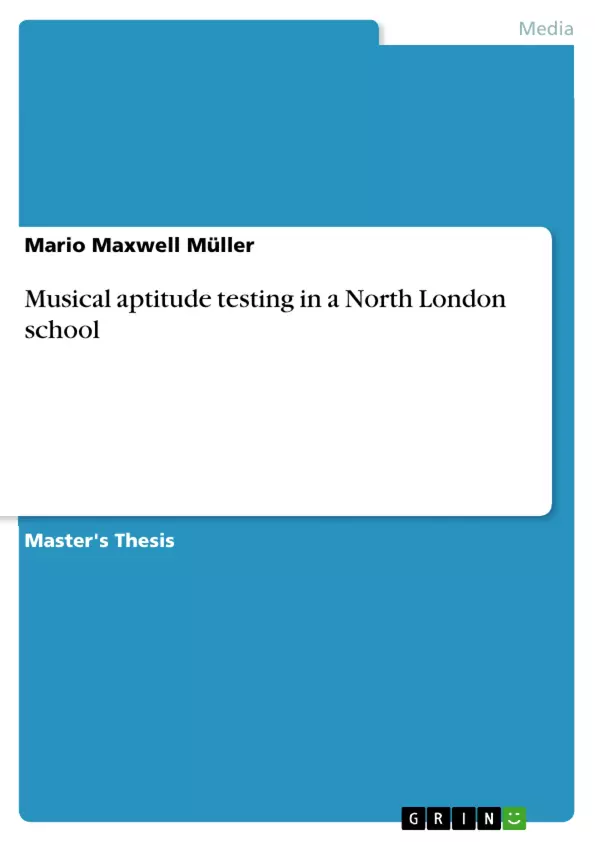Well-known musical aptitude tests designed by, among others, Seashore, Gordon, Bentley and Wing have been extensively discussed by several researchers, and this background is provided in this mini-dissertation. However, this research project was aimed at determining to what extent a newly
designed music listening test impacts on students‟ success rate in being judged to have particular musical aptitude. The purpose of this research was to evaluate what students score respectively for
four elements of music (pitch, melody, rhythm and texture) through a musical aptitude test designed by the author in consultation with colleagues in the Music Department at a school in North London in the United Kingdom .These tests were divided into two stages with students aged 10-13, of mixed genders and from different cultural backgrounds. The first focussed on the listening test (questionnaire) for a sample of 160 students. The second stage included practical performances (interviews and observations) and aural tests based on the elements: Rhythm, Melody, Improvisation, Two-part melody and Texture.
The results of the first stage revealed that the students particularly achieved high scores for the elements of music: melody and pitch. The age groups who scored the highest marks respectively were pupils aged 13. The results of the second sample of the respondents who completed the test revealed that the majority of the students had previous music tuition with the string instrument being the most
popular amongst respondents. This study revealed that students always respond to different sound qualities, followed by the identification of rhythmical patterns and melody. Their memory of pitch changes and develops further due to the possession of precise interval recognition and excellent memory recall.
Inhaltsverzeichnis (Table of Contents)
- Introduction
- Literature Review
- Research Methodology
- Data Analysis
- Discussion
- Conclusion
Zielsetzung und Themenschwerpunkte (Objectives and Key Themes)
This mini-dissertation aims to evaluate the effectiveness of a newly designed music listening test in assessing musical aptitude among students. The study explores the impact of this test on students' success rate in being judged to have particular musical aptitude. Key themes explored include:- The effectiveness of a newly designed music listening test in identifying musical aptitude.
- The relationship between listening test scores and students' performance in practical music tasks.
- The influence of previous music tuition on musical aptitude.
- The specific elements of music (pitch, melody, rhythm, and texture) that students excel in.
- The role of age and cultural background in musical aptitude.
Zusammenfassung der Kapitel (Chapter Summaries)
- Introduction: This chapter provides an overview of the research project, outlining its purpose, objectives, and the significance of the study. The chapter also discusses the background and rationale for the research, including the need for effective musical aptitude tests.
- Literature Review: This chapter explores existing literature on musical aptitude testing, focusing on well-known tests designed by Seashore, Gordon, Bentley, and Wing. The chapter critically analyzes these tests and discusses their strengths, weaknesses, and limitations.
- Research Methodology: This chapter details the methodology used for the research project, including the design of the music listening test, the sample selection, and the data collection procedures. The chapter also discusses the ethical considerations involved in the study.
- Data Analysis: This chapter presents the analysis of the data collected through the music listening test and practical music tasks. The analysis focuses on the performance of students in different age groups, genders, and cultural backgrounds. The chapter also explores the relationship between listening test scores and practical performance scores.
- Discussion: This chapter discusses the findings of the research project, drawing conclusions about the effectiveness of the newly designed music listening test in assessing musical aptitude. The chapter also explores the implications of the findings for music education and further research.
Schlüsselwörter (Keywords)
This mini-dissertation focuses on musical aptitude testing, music listening tests, music education, musical aptitude, pitch, melody, rhythm, texture, student performance, age, cultural background, and previous music tuition.- Quote paper
- Masters in Music Education with Distinction Mario Maxwell Müller (Author), 2011, Musical aptitude testing in a North London school, Munich, GRIN Verlag, https://www.grin.com/document/273655



